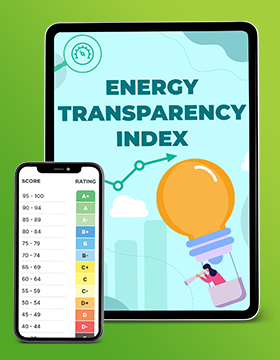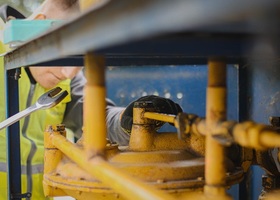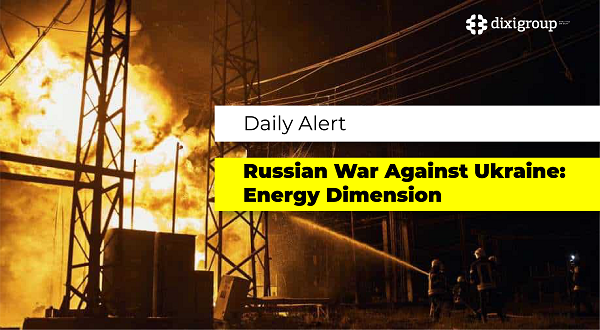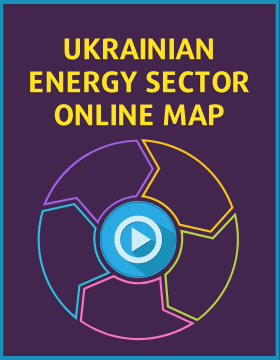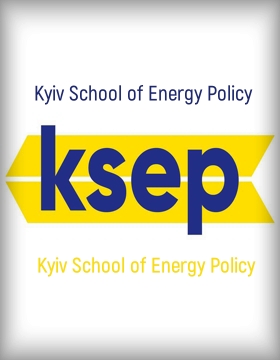A tipping point: How Canada is changing the gas market
New exporters enter the game, and Russia looks for a way out

After several years of gas shortages caused by sharp export restrictions from Russia, the global market is showing the first signs of a new phenomenon - excess supply. The turning point was the debut of liquefied gas supplies from the LNG Canada project, which took place on June 29.
Ukrainian Energy examined Canada's prospects in the gas market, the features of its competition with the United States, which is currently the largest LNG exporter in the world, and learned about the trends that determine the future of the gas industry.
Second Chance
LNG Canada is a joint venture of the Anglo-Dutch corporation Shell (40%), the Malaysian Petronas (25%), the Chinese PetroChina (15%), the Japanese Mitsubishi Corporation (15%) and the South Korean Korea Gas (5%). The total investment in this project (LNG production plant, port and pipeline infrastructure) is estimated at $40 billion. It is called the largest private investment in the history of Canada.
The plant is built in the Canadian province of British Columbia. Its current capacity is 14 million tons of LNG per year (20 billion cubic meters), with the potential to expand to 26 million tons (36 billion cubic meters).
LNG Canada's feature is direct access to the Pacific Ocean. The geographical location of the project contributes to the development of supplies to the markets of Japan, China and South Korea. "Therefore, it is a direct competitor to Sakhalin Energy - a plant of the Russian company Novatek with a capacity of about 11.5 million tons of LNG per year, also focused on the Asian market," notes Bloomberg.
The project will allow Canada to diversify exports, which were previously almost entirely focused on the United States. The first tanker GasLog Glasgow has set off for South Korea. The next delivery is expected to Malaysia.
Other large Canadian LNG projects - Woodfibre LNG and Cedar LNG - will be completed in 2027 and 2028. “This gives Canada a second chance to become a major player in the LNG market, a decade after the country’s promised LNG boom failed to materialize, but it is now reviving its ambitions to become a major exporter in the global gas market,” the regional publication CBC reported.
However, despite Canada’s plans, the United States continues to lag far behind in developing its LNG infrastructure. Some experts warn that Canada has already missed its chance to become a world-class player.
“I don’t think Canada will ever become a superpower in LNG exports. But it has the potential to significantly expand its capacity,” says Ed Crooks, vice president of the North American office of consulting firm Wood Mackenzie.
Ambitious hopes
One of the planned LNG export facilities is to appear in a small fishing community in the Vancouver area - in the village of Gingolks, which has the unofficial name of the “seafood capital” thanks to the local Nass River. Here they plan to build Ksi Lisims LNG - a floating terminal to supply LNG to customers in Asia. The project is being implemented by the local community in partnership with the industry group Rockies LNG (Canada) and Western LNG (USA).
“In a word, it is prosperity,” says Eva Clayton, who heads the Gingolks community. According to her, the community has gone “through hell” over the past 10 years to get the project off the ground. A final investment decision is expected this year.
Ksi Lisims LNG is one of seven Canadian LNG projects that are in the planning or preparation stages. Most of them involve local community participation or ownership - indigenous peoples - which is a significant shift compared to projects of a decade ago. At that time, several dozen LNG projects were proposed in British Columbia, but most of them were canceled due to regulatory barriers or the collapse of gas prices on the global gas market. At the same time, the United States had already begun to sell LNG (since 2016) to foreign buyers and subsequently became the world's largest exporter.
Industry experts believe that the different results of neighboring countries are explained by the level of political instability and bureaucracy that companies have faced in Canada. "One of the main problems is the enormous complexity of building any energy infrastructure in Canada," explains Ed Crooks. He notes that any project raises a lot of objections - from communities, various activists, environmental organizations, which criticize both specific locations and the impact on the environment in general.
But that is starting to change. The Canadian federal government, as well as the provincial governments of British Columbia and Ontario, have passed legislation to accelerate major projects. Surveys show that Canadians are becoming more open to new energy infrastructure, including pipelines.
Global demand for natural gas is expected to grow by 70-80% by 2050, according to Wood Mackenzie. This is due to population growth, energy needs for the world’s growing number of data centers and air conditioning, and industry’s shift from coal to gas.
Canada has large natural gas reserves, and the northwest coast of British Columbia offers a fast and safe route to Asian markets. But the United States is also interested in this opportunity. “While most of the US LNG terminals are located on the Gulf Coast and their priority is the premium markets of Europe, a new $50 million project is planned in Alaska. The White House supports it, providing $30 billion in guarantees. This could create serious competition,” warns Martin King, an analyst at Calgary-based consultancy RBN Energy. Heather Exner-Pirot of the Macdonald-Laurier Institute noted that the US project in Alaska has logistical difficulties - a long pipeline to the coast, difficult terrain, higher costs of delivering materials and labor. But unlike Canada, it has unanimous support at every level of government in the United States, from the governor to the energy minister.
Conservative MP Ellis Ross is even less optimistic about Canada’s prospects in the global gas market. “We’re hearing empty rhetoric, just rhetoric. This government, led by Liberal Mark Carney, is not sincere in its desire to make Canada an energy superpower,” he says.
Risks and opportunities
In the community of Kispiox, located on the Skini River, residents are concerned about the impact of the gas industry on the watershed and salmon population. They live near the Prince Rupert Gas Transmission pipeline that leads to the Ksi Lisims LNG plant.
“It’s one of the few places where you can still drink water straight from the river,” says local activist Colin Sutherland-Wilson. He is one of the plaintiffs in a case to stop the pipeline in the Supreme Court of British Columbia.
“Gas may be a better alternative to coal, but it is still a fossil fuel. And while the public’s attention on climate has now eased, the pendulum will swing back,” says Ed Crooks of Wood Mackenzie.
That means Canada has a narrow window of opportunity to strengthen its role in the international market as demand for LNG grows. Dulles Wang, head of Wood Mackenzie’s gas practice, says the next five to 10 years will be crucial. “After that, the future looks bleak because of the uncertain role of gas in the economy. Renewables have every chance of displacing it significantly,” he says.
Eva Clayton, who heads the local government in the village of Gingolks, hopes to start construction on the Ksi Lisims LNG plant next year, with the goal of seeing the first ship set off on an export journey as early as 2029. “It’s going to be incredible. It’s going to bring joy and growth to our community. And the benefits of this project will last a long time, not just a few years,” she said.
Radical change
In addition to the debut export from the LNG Canada project, on July 1, an even larger plant in the United States, in the state of Texas - Golden Pass - told US regulators that, despite delays, it plans to start work on starting production as early as October this year.
In total, about two dozen new projects - from North America to the Middle East - are expected to increase export capacity by more than 40% by 2030, outpacing demand growth and changing the market. For comparison: according to the International Gas Union, capacity increased by only 8% from 2020 to 2024.
“This powerful wave of supplies is not a surprise - most projects were approved before the pandemic. However, bottlenecks in production chains and high costs have repeatedly postponed launch dates.
The loss of Russian gas to Europe after the full-scale invasion of Ukraine in February 2022 has further narrowed the market, leading to high and unstable prices that have raised doubts about demand from developing countries.
“Currently, some Asian buyers are postponing long-term contracts precisely because they foresee a future surge in supply - and therefore more favorable terms. But there is a nuance: the ultra-low prices for LNG that consumers expect are not guaranteed,” Bloomberg notes.
Russia’s Constraints
One of the key unknowns in the face of a future surplus is how quickly major producers will be able to increase their announced supplies in practice. For example, the US, already the world’s largest LNG exporter, wants to double its exports by 2030. Qatar wants to increase production by 85% by 2027. Questions also remain about Russia, which is trying to expand its LNG exports despite sanctions pressure. Since most of its pipelines are oriented towards Europe, the country is forced to look for other ways to supply gas to the east, to Asia. These plans depend on the easing of US sanctions policy, but Moscow is already trying to resume shipments from the Arctic LNG-2 project, which was effectively frozen last year due to US restrictions.
One of the key unknowns in the face of the impending surplus is how quickly major producers will be able to increase their announced supplies in practice. For example, the United States, already the world’s largest LNG exporter, wants to double its exports by 2030. Qatar wants to increase production by 85% by 2027. Questions also remain about Russia, which is trying to expand its LNG exports despite sanctions pressure. Since most of its pipelines are oriented towards Europe, the country is forced to look for other ways to supply gas to the east, to Asia. These plans depend on the easing of US sanctions policy, but Moscow is already trying to resume shipments from the Arctic LNG-2 project, which was effectively frozen last year due to US restrictions. As Ukrainian Energy reported, the European Commission is proposing to ban imports of Russian gas altogether from 2027 – both pipeline and LNG-shipped. New supply contracts will not be concluded from January 1, 2026, and existing ones will be valid for another 2.5 years.
Currently, EU countries continue to buy significant volumes of Russian gas: in the first four months of 2025, they spent more than 5 billion euros on it - this is 17% more than in the same period last year. Two-thirds of imported LNG comes from the Arctic - from the Yamal LNG project of Novatek. According to the calculations of researcher Malte Humpert, by the time of a complete ban, EU countries may pay Russia from 10 to 15 billion euros for gas from this plant.
“As supply increases, the mood in the market will inevitably change. After years of sellers' dominance, traders should prepare for a market where buyers will have power, and available Russian gas will become less and less,” concludes Bloomberg.
Svitlana Dolinchuk, specially for Ukrainian Energy

